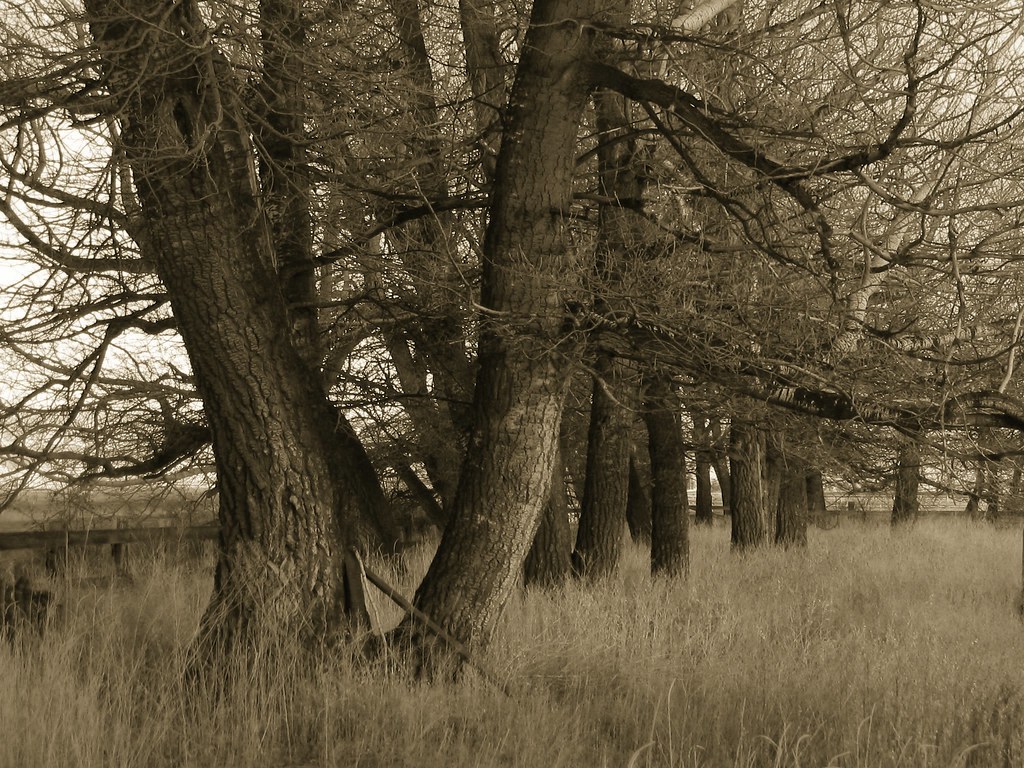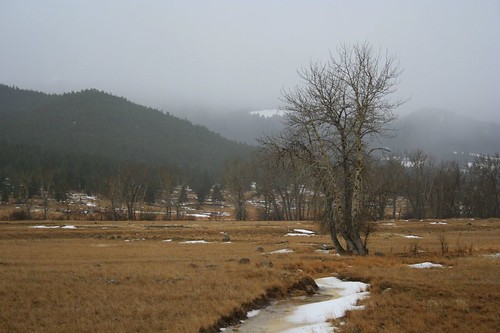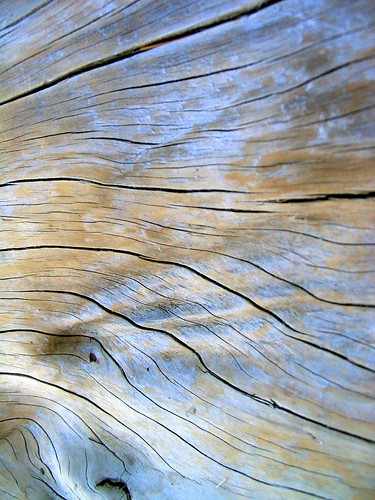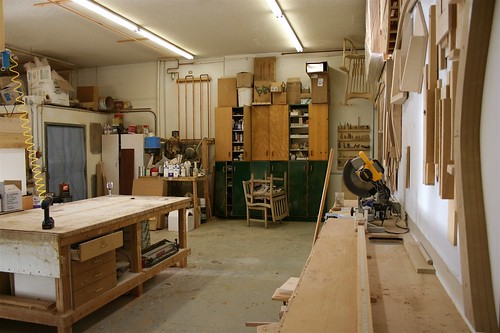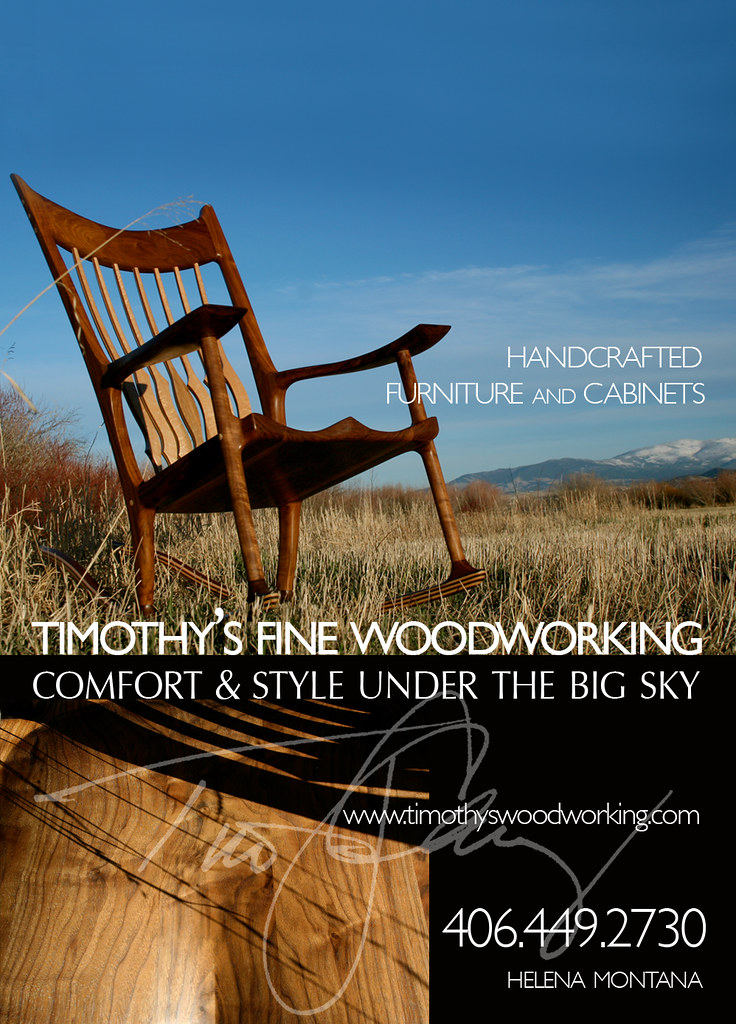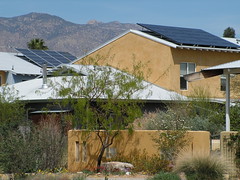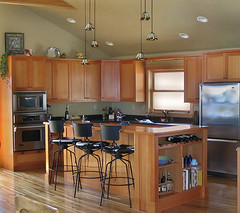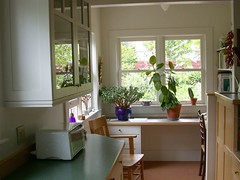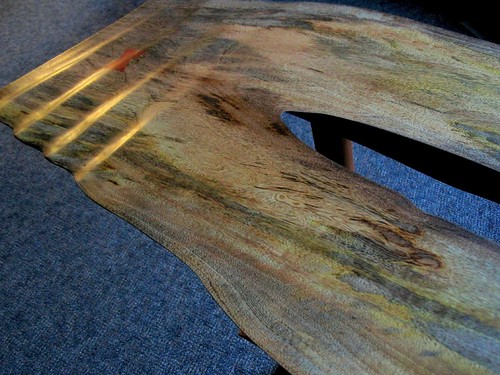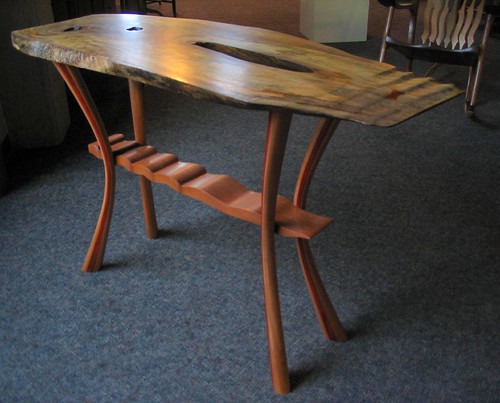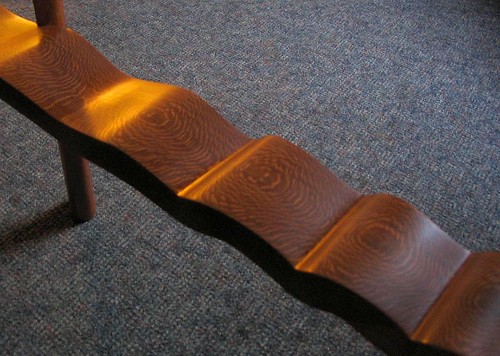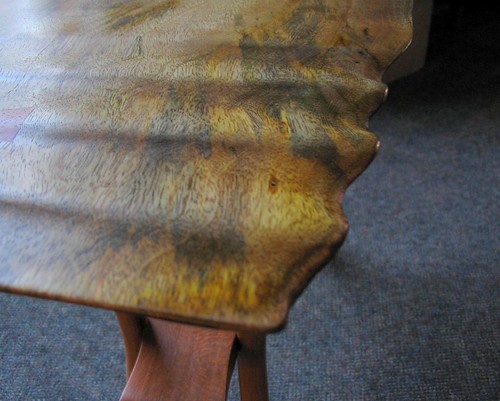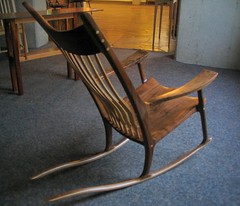Ad for Timothy’s Fine Woodworking August/September 07
Category: Shop Talk
blog posts
A Meditation on Trees: Hermann Hesse
A skilled woodworker, I believe, is one who has learned to listen to trees, who has learned a few life-lessons by working with the beautiful, strong bodies of trees and who has learned to see the soul of a tree in the roughcut slabs of wood.
The German writer, Hermann Hesse published a thoughtful collection of poems and travel prose in 1917, titled, Wandering. The book was translated in 1974 by James Wright. One does not have to be religious to appreciate Hesse’s love of the natural world and his urge to find oneness Below are short excerpts about learning wisdom from the trees around us:
Whoever has learned how to listen to trees no longer wants to be a tree. He wants to be nothing except what he is. That is home. That is happiness.
… For me, trees have always been the most penetrating preachers. I revere them when they live in tribes and families, in forests and groves. And even more I revere them when they stand alone. They are like lonely persons. Not like hermits who have stolen away out of some weakness, but like great, solitary men, like Beethoven and Nietzsche.
… Nothing is holier, nothing is more exemplary than a beautiful, strong tree. When a tree is cut down and reveals its naked death-wound to the sun, one can read its whole history in the luminous, inscribed disk of its trunk: in the rings of its years, its scars, all the struggle, all the suffering, all the sickness, all the happiness and prosperity stand truly written, the narrow years and the luxurious years, the attacks withstood, the storms endured.
Every young farmboy (and I would say, woodworker) knows that the hardest and noblest wood has the narrowest rings, that high on the mountains and in continuing danger the most indestructible, the strongest trees grow.
Trees are sanctuaries: whoever knows how to speak to them, whoever knows how to listen to them, can learn the truth. They do not preach learning and precepts. They preach, undeterred by particulars, the ancient law of life.
A tree says: A kernel is hidden in me, a spark, a thought, I am life from eternal life. The attempt and the risk the eternal mother took with me is unique, unique the form and veins of my skin, unique the smallest play of leaves in my branches and the smallest scar on my bark. I was made to form and reveal the eternal in my smallest special detail.
A longing to wander tears my heart when I hear trees rustling in the wind at evening. If one listens to them silently for a long time, this longing reveals its kernel, its meaning … It is a longing for home, for a memory of the mother, for new metaphors for life. It leads home. Every path leads homeward, every step is birth, every step is death, every grave is mother.
So the tree rustles in the evening, when we stand uneasy before our own thoughts. Trees have long thoughts, long-breathing and restful, just as they have longer lives that ours. They are wiser than we are, as long as we do not listen to them …
Whoever has learned how to listen to trees no longer wants to be a tree. He wants to be nothing except what he is. That is home. That is happiness.
— excerpts from Hermann Hesse: Wandering, translated by James Wright, © 1974 Farra, Straus & Giroux
— Maureen
The (almost) complete excerpt is posted at my blog, Raven’s Nest. Click here to read that article.
You know how one thing leads to another…..?
Well, Tim and Tracy cleaned the shop! And it was a rather large new “baby” that motivated the cleanup. Check it out:
Tim is the proud new parent of an AEM wide-belt sander … he and Doug Kralicek, of Kralicek Millworks, drove over to Pinesdale, Montana to pick it up a week ago. Huge thing!
I (Maureen) had no idea how big it was until the day I dropped by to shoot some photos of the beast — it was still in Doug’s trailer and Tim, his electrician, Jim White and one of Doug’s employees were scratching their heads over how to get the danged thing out of the trailer and into the shop.
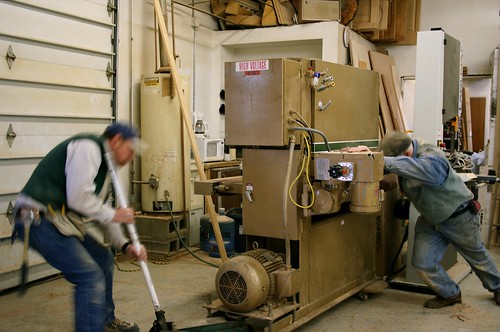 In the process of making room for the new overhead sander (and moving the older, smaller one out) Tim got all jazzed up about cleaning and organizing the shop. It was dusty. Yep. His shop was also pretty crammed with lumber, sheet goods, cabinet boxes in the midst of assembly, stuff stuff and more stuff — and oh, did I mention the sawdust? So, Tracy and Tim spent the entire last week (Tim did the weekend too) cleaning, organizing, tossing, taking stuff to our local salvaged-building-materials store — ReStore — as well as to the dump.
In the process of making room for the new overhead sander (and moving the older, smaller one out) Tim got all jazzed up about cleaning and organizing the shop. It was dusty. Yep. His shop was also pretty crammed with lumber, sheet goods, cabinet boxes in the midst of assembly, stuff stuff and more stuff — and oh, did I mention the sawdust? So, Tracy and Tim spent the entire last week (Tim did the weekend too) cleaning, organizing, tossing, taking stuff to our local salvaged-building-materials store — ReStore — as well as to the dump.
All these years, Tim’s had to store all of this supplies and materials for woodworking right in the shop. Some of that stuff he brought with him from Pocatello and hasn’t looked at since the day he moved into the shop. Would ya say he might not need it anymore? The folks down at ReStore were happy to have all of his give-aways and I bet now a few days later, that stuff has found new homes all over Helena.
 Well, one thing led to another. Or I should say, one good idea led to an even better idea. The brainstorm was to get a container to store most of the shop’s wood. That cleared a huge space. And the huge space turned into even more working room in the shop.
Well, one thing led to another. Or I should say, one good idea led to an even better idea. The brainstorm was to get a container to store most of the shop’s wood. That cleared a huge space. And the huge space turned into even more working room in the shop.
A few days later, I was truly amazed. Tim took me over to the shop last night to show me the changes. Whoah! I hardly recognized the place! He had re-opened a double-wide doorway between the two sides of the shop, making the work flow much more efficient and comfortable.
 Now an entire wall is available for hanging the large collection of jigs, templates and patterns within easy reach. They divided the shop more clearly into two rooms, and both rooms are much better connected with two large doors and a large window to allow light to penetrate from the assembly room, below, into the machine room.
Now an entire wall is available for hanging the large collection of jigs, templates and patterns within easy reach. They divided the shop more clearly into two rooms, and both rooms are much better connected with two large doors and a large window to allow light to penetrate from the assembly room, below, into the machine room.
The assembly room (in both photos above) holds their workbenches, chop saw, spray booth, assembly benches, hardware storage and a cabinet for finishes.
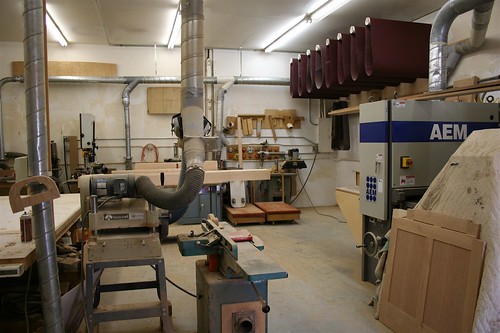 The machine room now has more room to manuever large pieces of lumber around all of the machines.
The machine room now has more room to manuever large pieces of lumber around all of the machines.
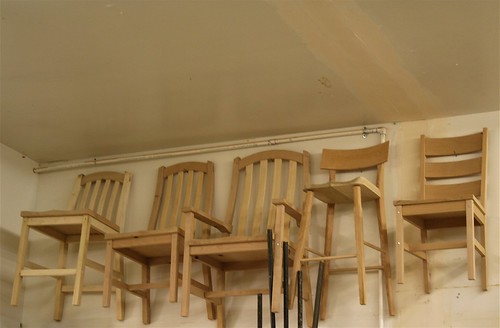
On Sunday, Tim assembled all of his chair prototypes (which had until then been mostly piles of parts.) He hung the prototypes from the ceiling. What a good idea — plus they look cool hanging up there like wallflowers at a highschool prom.
It’s going to be a much more enjoyable place to work for both guys.
Until next time,
Maureen
Rockin’ it in Big Sky Country
Found on the Web: What does Green Really Mean?

Photo from Fine HomeBuilding pdf article. Click photo to read the article
Okay, it’s really happening — green is the latest building and design industry buzzword. Heck, even the Wall Street Journal writes that the sustainable design/green-building movement has become mainstream. You know builders have jumped on the bandwagon when the National Association of Home Builders announces that it is standardizing it’s voluntary green building guidelines.
Pick up any remodeling, home decorating, interior or architectural design magazine and you’ll find at least one feature article on going “green.” Yet how do you know, with all the green stuff coming at you from every direction, if what you are getting is really, truly green — in the sense of environmentally friendly?
Fine Home Building (Taunton Press) has long published news about the green building movement, even before it was trendy. Tim has subscribed to Fine Home Building for many years – the publication is an excellent source of inspiration, ideas and reference articles. The latest issue of FHB includs an excellent article by editor, Scott Gibson titled, What Does Green Really Mean?
Check out Scott’s article. And if you’re back this way, please leave us a comment — let us know what you think about the green building movement! Thanks for reading.
8 Ways to Make Your Home Greener
Sustainability is a word that is often misunderstood. For many people, sustainability or “green” means “environmentally friendly” But it is more than reducing waste, protecting the environment and recycling. Sustainability is a process that enables all people to realize their potential and to improve their quality of life in ways that (also) protect and enhance the Earth’s life support systemsOfrom the Forum for the Future) To understand sustainability we must become aware of how everything we do, everything we take, everything we make and everything we waste affects nature’s balance and how our actions will ultimately affect our children and all of Earth’s children.
Each choice we make has a cost that is a combination of the economic, social and environmental costs set against each choice’s benefits.
In a recent study six out of ten homeowners said they would like to use sustainable, environmentally responsible design and materials in their home projects whether that means for new home construction or home remodeling. Whether they would actually use green materials depends largely on cost and looks. Here we will take a look at both of these issues and give you some ways you can — gradually — add the color green to your new or remodeled home.
Cost has been a deterrent to many people when they are deciding whether to spring for green building materials or stick with the old tried-and-true. Because energy costs are rising sharply with no relief in sight, at least some green building materials’ costs are now closer to the non-green materials. Plus, homeowner interest in sustainable design and materials is growing rapidly — and as interest rises, so does the demand for these products, which eventually will bring costs down further. It would take a whole other article to discuss the ROI (return on investment) concept, something we’ll take up another time.
In Montana, our challenge is finding green building materials at a reasonable cost. There are added transportation costs and fewer distributors of these products in Montana. As more people ask for and demand environmentally responsible products, I hope their availability and affordability improves.
There are other ways to address the higher cost of earth-friendly materials. If you are building a new home and want to use “green” flooring such as cork, carpet made with no formaldehydes and with 100% recycled fibers, for example, it will cost lots more if you are covering 3000 square feet of floor versus if you build a smaller home in the first place and only have to install floor covering on 2000 square feet. Smaller homes are more efficient to heat as well, and the total cost of all building materials for a smaller home saves you enough that you may be able to afford to make greener choices.
 The look of green building materials is another issue. Many people are under the impression that green — environmentally responsible — design and materials, are either ugly, clunky or inelegant in appearance. This perception may be leftover from the early days of earth sheltered homes made with black painted oil drums, salvaged lumber, wine bottle walls and cedar hot tubs. On the contrary, most environmentally responsible materials and design methods today are not only beautiful, but they have a simple elegance unmatched in traditional materials. Interior designers and architects are specifying earth-friendly materials that are downright elegant and truly gorgeous. Besides, I personaloly believe salvaged lumber has a warmth and history that fits nicely with traditional or contemporary home styles.
The look of green building materials is another issue. Many people are under the impression that green — environmentally responsible — design and materials, are either ugly, clunky or inelegant in appearance. This perception may be leftover from the early days of earth sheltered homes made with black painted oil drums, salvaged lumber, wine bottle walls and cedar hot tubs. On the contrary, most environmentally responsible materials and design methods today are not only beautiful, but they have a simple elegance unmatched in traditional materials. Interior designers and architects are specifying earth-friendly materials that are downright elegant and truly gorgeous. Besides, I personaloly believe salvaged lumber has a warmth and history that fits nicely with traditional or contemporary home styles.
Okay, so how can you green your home incrementally if you don’t want to or can’t afford to do it all at once? here are 8 suggestions:
1) If you are looking for a new home, find one within walking distance of schools, workplaces, parks and grocery stores. If you can walk to most destinations, you will use less gas. To me, that means your home is greener!
2) Build on an infill lot. Most new housing has greater environmental consequences, with development replacing open space and agricultural land. New housing also requires new infrastructure such as roads and utilities. A new home built on a vacant lot (infill) uses existing roads and utilities.
3) For any new building, choose technologies such as solar panels, high R-value insulation and low-impact building methods and materials.
4) Design your new home to be more energy efficient and use less resources. You can do this by simply building a smaller, better-designed house. Large homes use more resources and may require more energy to heat and maintain than small to mid-sized homes. A smaller home on a smaller lot can be equally if not more satisfying to the soul, as author and architect, Sarah Susanka writes in her book, The Not So Big House.
4) Even better than building new, remodel an existing home to improve its’ energy efficiency. Install double-paned windows, Energy-Star appliances, an efficient furnace and hot water heater and energy efficient lighting can reduce home energy bills by over 30 percent.
 5) Remodel to make your home greener — just a little at a time. Whenever possible, choose environmentally preferable products such as low-gas paints, formaldehyde-free plywood, carpets made of recycled plastics, cork and linoleum flooring (both made of low-impact renewable resources,) countertops and kitchen cabinets made of recycled or earth-friendly materials and sustainably harvested wood.
5) Remodel to make your home greener — just a little at a time. Whenever possible, choose environmentally preferable products such as low-gas paints, formaldehyde-free plywood, carpets made of recycled plastics, cork and linoleum flooring (both made of low-impact renewable resources,) countertops and kitchen cabinets made of recycled or earth-friendly materials and sustainably harvested wood.
6) When purchasing cabinets and furnishings for your home, consider spending a little more for the best quality you can afford. Well made, classically designed cabinetry and furniture will remain stylish and last longer than cheap, lower quality home furnishings. In the end, high quality products cost you less and protect the environment because you don’t have to replace them.
7) Landscape your home — either new, or remodeled — to conserve heating and cooling energy. Plant shade trees to shield your home from hot summer sun. If you plant deciduous trees on the sunny side of your house, you will have shade in summer and sunlight in winter. Evergreen trees and shrubs can also conserve energy by lifting cold winter winds up and over the house.
8) Design your home’s landscape to conserve water and fossil fuels: read up on Xeriscaping methods, choose drought-tolerant plants, and substitute plant beds or hardscaping (deck, patio, pathways) for thirsty, energy-intensive lawns. Remember to use as many locally available materials as possible.
Certified high quality wood products
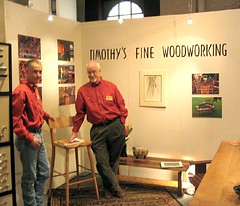
As much as possible, we build our furniture, cabinets and other home furnishings using FSC-certified wood products. That’s how we and our customers can support environmental practices without sacrificing high quality and elegant design.
Until recently it was almost impossible to find FSC-certified hardwood products and no-added-formaldehyde veneers and plywoods for our woodworking shop. Gradually, as the interest and demand for environmentally responsible materials has increased, so has the availability. The cost is also slowly coming into line with traditionally manufactured wood products. I hope that soon you will not be able to find wood products manufactured with formaldehyde glues and other environmentally degrading byproducts.
Columbia Forest Products now offers a line of 100% certified decorative wood panels and veneered particleboard that carries the Forest Stewardshop Council (FSC) ecolabel and qualifies toward the US Green Building System requirements. Visit their website for more information on this line of products.
If you are concerned about the health and environmental affects of formaldehyde-containing wood products used in your home, ask your builder, carpenter, architect or contractors to specify veneers and plywoods with no-added-formaldehydes. If enough people request these more environmentally friendly materials, the availability will increase and the cost will go down.
Inspiration: The Yellowstone
The Helena Woodworker’s Guild recently held their annual exhibit at the Myrna Loy Center for the Arts in Helena, Montana. We put the show up on December 3 and held our opening reception on December 10th, the night of the Helena Winter Art Walk. We had pieces by John Hinshaw, Priscilla Bode, Tim Carney, Travis Smith, Chris Yavah. We had great attendance at the opening, a good time and hopefully generated lots of interest in the abilities of Helena’s many talented woodworkers. We’ll be posting some photos of the exhibit and opening soon.
In the meantime, I would like to introduce Tim’s most recent one of a kind piece, The Yellowstone, inspired by one of North America’s most awesome rivers and national parks. This hall table’s live-edge slab top is made of curly mango accented with carved ripples in one end. The trestle is a sinuous fluid shape carved of lacewood and the legs’ tapered laminations are of padauk and mahogany.
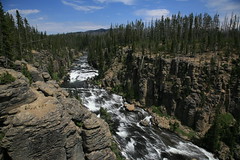
Lewis River Canyon, Yellowstone Park Photo by Hayden61
Yellowstone Park is filled with natural wonders that have fascinated people for hundreds – or thousands – of years. Yet there are beautiful forces equally as passionate, hidden under the surface of the land. Firey reds, sulphuric yellows and vibrant turquoises are created by minerals pushed from deep under the earth’s crust. In Yellowstone Gorge, you can see colors in the geological layers like paint dripping on a gigantic canvas.
 And though we can see evidence of earth’s geothermal activity in the paint pots, geysers and bubbling hotsprings of the park, imagine what we can’t see … the power and lifeforce under the surface.
And though we can see evidence of earth’s geothermal activity in the paint pots, geysers and bubbling hotsprings of the park, imagine what we can’t see … the power and lifeforce under the surface.
Although the table top itself is fine to look at, if you look beneath the live-edge slab top, even through the knot holes you can see layers of the piece. Tim carved “ripples” in the table top, where the slab’s shape seemed to naturally flow like water. He chose lacewood to make a rippling trestle, because lacewood’s grain also recalls the turbulence and dancing movement of rough river whitewater. Or when a trout rises to mouth the reflecting river’s surface.
The legs are shaped with the thought of the volcanic activity and subsurface underneath Yellowstone Park.
Exhibit
Hi Ken and Mary. I’m just gonna leave this blog post up for awhile to make it easy for you to get to Tim’s flickr albums. Just click on the photo of the rocking chair (which, by the way, is the one Tim made for me – isn’t he a sweetie?) Anyway, just click on the photo and it will take you to Tim’s flickr page. In order to comment under any of his flickr photos, you have to sign up for a free flickr account (which is a very cool online photo storage service) … but I think you can make comments on any of Tim’s blog posts here at Shop Talk, without doing anything like registering. and don’t worry – we won’t spam you. [grinning]
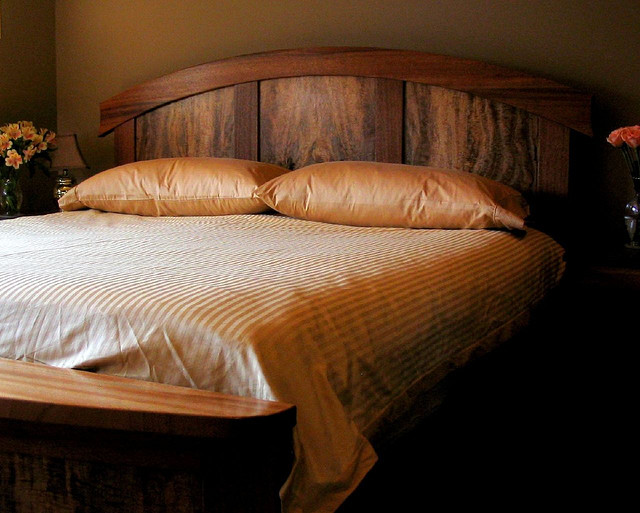
Mango & Mahogany Bedroom Set
This custom designed master bedroom set includes a mahogany and mango bed with curving headboard, a curved footboard that also functions as a seat, two bedside tables and a mahogany mirror above the owner’s black dresser.
The graceful Asian inspired lines of African Mahogany frame highly figured Curly Mango panels. The footboard curves out forming a seat that reflects the curves of the headboard and mirror. The overall feeling of the furniture contributes to a peaceful and restful bedroom atmosphere.
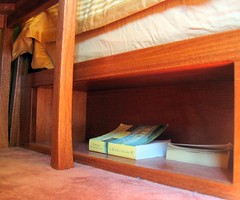
There is a bookshelf neatly tucked in the most convenient place — right up near the top of the bed. Isn’t this where books and papers tend to collect anyway? Why not make an intentional place to keep your bedtime reading?
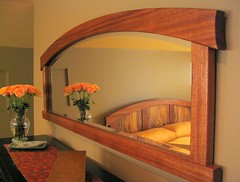 The mahogany mirror matches the bed, reflected here.
The mahogany mirror matches the bed, reflected here. 
A curved footboard also functions as a seat.

